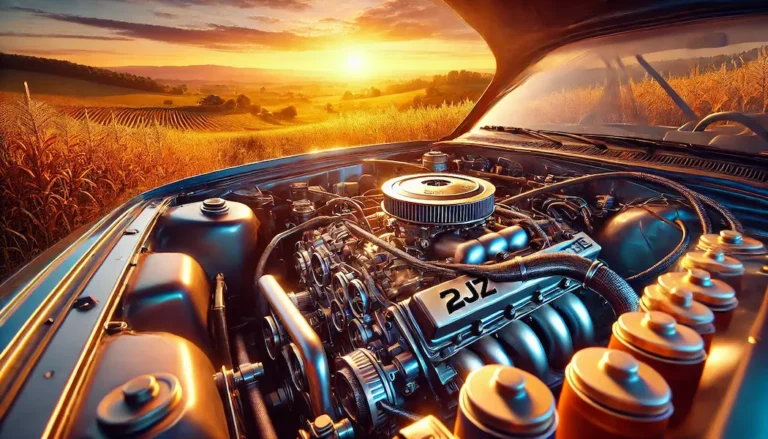RB26 Engine: The Heart of Nissan’s Performance

Key Takeaways:
- The RB26 engine is a true icon in the automotive world, known for its remarkable blend of power, reliability, and tuning potential.
- This inline-six, twin-turbo engine has been a favorite among tuners, racers, and enthusiasts, achieving massive success in motorsports.
- With over 1,000 horsepower in some custom builds, the RB26 is more than just an engine; it’s a symbol of automotive culture.
- From the racetrack to Hollywood and video games, the RB26’s influence on car culture is undeniable.
Introduction to the RB26 Engine
The RB26 engine is at the heart of Nissan’s performance legacy. Widely regarded as one of the most iconic engines in automotive history, the RB26 was developed not just for speed, but for dominance in motorsports. Its seamless combination of power, smoothness, and tuning potential has made it a legend, not only on racetracks but also on the streets and in popular culture. Whether it’s appearing in movies like Fast & Furious or inspiring racers to push the limits of performance, the RB26 continues to influence the world of cars today.
Origins: The Birth of the RB26 Engine
Introduced in the late 1980s, the RB26 engine was designed by Nissan to conquer Group A motorsports. This was an era when racing was fierce, and Nissan needed a powerplant that could deliver both speed and reliability under extreme conditions. The RB26 didn’t just meet these demands; it exceeded them. As time went on, this race-bred engine transitioned into street cars, making it a favorite among car enthusiasts. The RB26’s incredible versatility and engineering excellence quickly established it as one of the most revered engines in automotive history.
Technical Specifications: Inside the RB26
The RB26 is known for its balance between power and reliability, thanks to its thoughtful design and high-performance engineering. Here’s a closer look at its key specifications:
- Engine Configuration: The inline-six design delivers smooth, vibration-free performance, even at high speeds.
- DOHC, 24-Valve Layout: This provides superior airflow, making the engine highly responsive at higher RPMs.
- Displacement: The 2.6-liter capacity (with an 86mm bore and stroke) offers a perfect balance for high-revving performance.
- Turbocharged System: With twin small ceramic turbos, the RB26 delivers quick spool times and thrilling acceleration.
RB26 Variants and Evolution
Over the years, the RB26 has evolved to meet the needs of different motorsport and street applications. Here are a few notable variants:
- RB26DETT: The most famous version of the engine, known for its twin-turbo setup. It was first introduced with a solid engine block but later improved with better cooling and oil flow systems.
- N1 Engine: Designed specifically for motorsports, this version features enhanced durability and reinforced internals, perfect for high-stress racing environments.
The RB26 in Motorsports
From racetracks to drifting competitions, the RB26 engine has been a key player in various motorsports, making its mark in both Japan and around the world.
- Group A Racing: The RB26 powered the Nissan Skyline GT-R to dominate Group A racing during the late 1980s and early 1990s. The car’s dominance earned it the nickname “Godzilla.”
- Drifting and Time Attack: Known for its smooth power delivery, the RB26 is a favorite among professional drifters and time attack racers who rely on precision and reliability in high-pressure environments.
The Legacy of the RB26 and Its Impact on Nissan
The RB26 engine’s legacy is intertwined with the Nissan Skyline GT-R, forming a partnership that produced some of the most legendary cars ever made. The R32, R33, and R34 Skyline GT-R models are all famous for their performance, and the RB26 engine was key to their success.
- R32 Skyline GT-R: The first model to feature the RB26, this car made history with its all-wheel-drive system and the RB26’s ability to dominate on both the track and street.
- R33 Skyline GT-R: Improved aerodynamics and a more rigid chassis made the R33 smoother and more stable, taking the RB26’s potential even further.
- R34 Skyline GT-R: The pinnacle of the RB26’s development, the R34 featured advanced electronics and real-time performance monitoring, further cementing the RB26 as one of the greatest engines ever produced.
Aftermarket Potential and Tuning the RB26
One of the reasons the RB26 remains popular today is its vast aftermarket support and impressive tuning potential. With simple upgrades, the engine’s power can be pushed beyond 600 horsepower, and with more extreme modifications, over 1,000 horsepower is achievable.
- Common Upgrades: Turbo upgrades, ECU tuning, and high-performance exhaust systems are some of the most popular mods for the RB26, helping to increase both power and efficiency.
- Reliability: While the RB26 is known for its durability, it’s essential to maintain it properly. Regular oil changes, cooling system upgrades, and replacing timing belts at recommended intervals will help keep the engine running smoothly.
Cultural Impact of the RB26
The RB26’s impact goes far beyond motorsports. It has become a symbol of car culture, appearing in movies, video games, and tuning communities around the world.
- In Film and Video Games: Most famously, the RB26-powered Skyline GT-R appeared in the Fast & Furious franchise, introducing the engine to millions of viewers. It also plays a prominent role in racing games like Gran Turismo and Need for Speed.
- Car Enthusiasts and Tuners: For car enthusiasts, the RB26 is more than just a powerful engine; it’s a symbol of innovation and passion. Its influence can be seen in countless builds and modifications across the globe.
Conclusion
The RB26 engine has earned its legendary status for a reason. It’s more than just a powerhouse under the hood; it represents the epitome of automotive engineering. With its roots deeply embedded in motorsports, it has influenced both modern performance engines and car culture as a whole. The RB26’s combination of power, reliability, and tuning potential has made it a favorite in the aftermarket community, ensuring its place in history. As the years go by, this iconic engine continues to inspire new generations of car enthusiasts and racers alike, securing its legacy as one of the greatest engines of all time.
Frequently Asked Questions (FAQs)
How does the RB26 compare to the 2JZ engine?
While both engines are iconic, the RB26 stands out for its motorsport origins and its exceptional balance of power and reliability.
What makes the RB26 engine so special?
Its inline-six configuration, twin-turbo system, and strong reliability make it a top choice for tuners and car enthusiasts.
How much horsepower can a stock RB26 handle?
A stock RB26 can handle around 500 horsepower, but with modifications, its potential skyrockets to over 1,000 horsepower.
What are the common issues with the RB26?
Oil starvation and overheating are common issues, particularly in tuned engines. Regular maintenance is key to avoiding these problems.
Is the RB26 engine still relevant today?
Absolutely! The RB26 remains a favorite in the tuning world due to its legendary status and vast upgrade potential.
Thanks for checking out this article on EngineEcho.com! Hope you found this article: "RB26 Engine: The Heart of Nissan’s Performance" helpful! If you liked it and want to dive into more car engine topics, head over to our homepage. There's always something new to discover in the world of engines. Enjoy your reading journey!
Check out our previous article: 2JZGTE Engines for Sale: Best Deals






